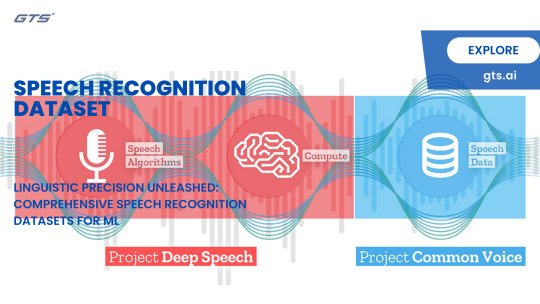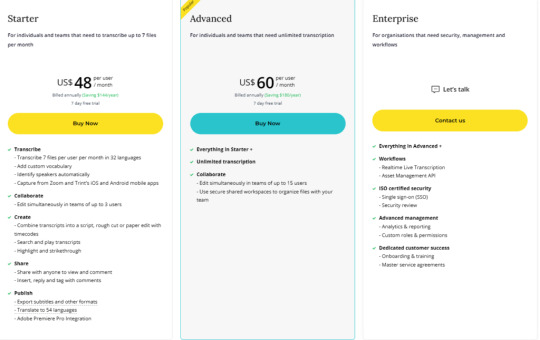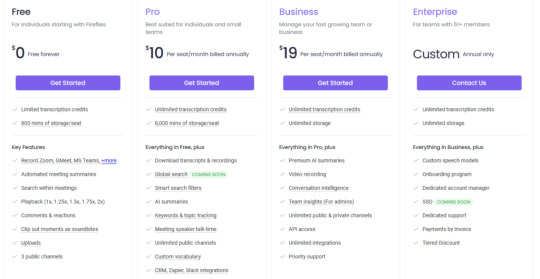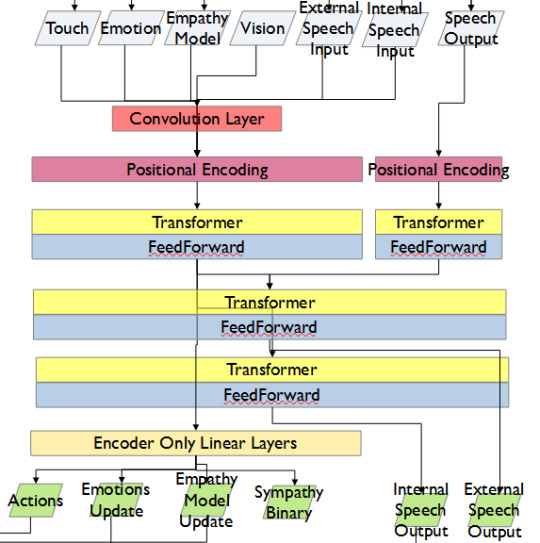#speechrecognition
Text

Transforming Conversations: The Power of AI Voice Technology
Experience the transformational power of AI Voice technology. Discover how it simplifies daily tasks, improves accessibility, and enhances voice-based interactions. Explore the possibilities of AI Voice and revolutionize the way you communicate.
For more information : https://www.ringflow.com/business-phone-service/
Contact Us :
👉 Email:- [email protected]
👉 WhatsApp:- 1 917-254-4289
#PowerOfAiVoice#RevolutionizeConversations#SpeechRecognition#NaturalLanguageProcessing#PersonalizedInteractions#ElevateCommunication#AiVoiceAdvancements#RealTimeAssistance#HandsFreeInteractions
1 note
·
View note
Text
Speech to Text Online: Transforming the Way We Communicate
In today's fast-paced digital world, efficiency and convenience are paramount. Whether you're a student, professional, or simply someone looking to streamline your daily tasks, the ability to convert speech to text online has become an indispensable tool. This article delves into the realm of speech to text online services, exploring their benefits, functionality, and how they are revolutionizing communication.
Understanding Speech to Text Online:
Speech to text online services utilize advanced algorithms and artificial intelligence to transcribe spoken words into written text. These platforms offer users the ability to dictate messages, documents, emails, and more, eliminating the need for manual typing. By harnessing the power of machine learning, these services continuously improve accuracy and efficiency, making them invaluable in various settings.
Advantages of Speech to Text Online:
Enhanced Productivity: By eliminating the need for manual typing, speech to text online services significantly enhance productivity. Users can dictate messages or documents in a fraction of the time it would take to type them manually.
Accessibility: These services cater to individuals with disabilities or mobility impairments, providing them with a means to communicate effectively without relying solely on traditional typing methods.
Multitasking: With speech to text online, users can multitask efficiently. Whether driving, cooking, or engaging in other activities, individuals can dictate messages or notes hands-free, maximizing efficiency.
Improved Accuracy: Thanks to advancements in machine learning algorithms, speech to text online services boast impressive accuracy rates, minimizing errors and ensuring the faithful transcription of spoken words.
How Speech to Text Online Works:
Speech to text online platforms employ sophisticated algorithms to process spoken language. Upon receiving audio input, these systems analyze speech patterns, vocabulary, and context to generate accurate transcriptions. Through continual learning and refinement, these platforms adapt to users' speech patterns, further enhancing accuracy over time.
Applications of Speech to Text Online:
Professional Settings: Speech to text online services are widely used in professional settings, allowing professionals to dictate emails, reports, and other documents efficiently.
Educational Settings: Students can benefit from speech to text online services to transcribe lectures, take notes, or create study materials, enhancing accessibility and facilitating learning.
Accessibility Tools: These services serve as invaluable accessibility tools for individuals with disabilities, enabling them to communicate effectively and access digital content with ease.
Content Creation: Content creators leverage speech to text online services to draft articles, scripts, and other written content quickly and efficiently, streamlining the content creation process.
Addressing Common Concerns:
Is Speech to Text Online Secure?
Yes, reputable speech to text online platforms prioritize user privacy and employ stringent security measures to safeguard sensitive information. Data encryption, secure servers, and adherence to data protection regulations ensure user confidentiality.
Can Speech to Text Online Replace Manual Typing?
While speech to text online offers unparalleled convenience, it may not completely replace manual typing in all scenarios. Certain tasks may still require manual input, particularly those involving complex formatting or specialized terminology.
How Accurate are Speech to Text Online Services?
Speech to text online services have made significant strides in terms of accuracy, with leading platforms boasting impressive accuracy rates exceeding 90%. However, accuracy may vary depending on factors such as background noise, accents, and speech clarity.
Are Speech to Text Online Services Cost-Effective?
Many speech to text online services offer affordable subscription plans or pay-as-you-go models, making them accessible to individuals and businesses of all sizes. The time saved and productivity gained often outweigh the associated costs.
Can Speech to Text Online Services Recognize Multiple Languages?
Yes, most speech to text online platforms support multiple languages, allowing users to dictate in their preferred language seamlessly. This feature caters to diverse linguistic needs and enhances accessibility for users worldwide.
How Can I Get Started with Speech to Text Online?
Getting started with speech to text online is simple. Choose a reputable platform that aligns with your needs, create an account, and begin dictating. Many platforms offer user-friendly interfaces and intuitive controls, ensuring a seamless user experience.
Conclusion:
Speech to text online services have emerged as indispensable tools, offering unparalleled convenience, efficiency, and accessibility. Whether in professional, educational, or personal settings, these platforms empower users to communicate effectively and streamline their daily tasks. With continued advancements in technology, speech to text online is poised to transform the way we interact with digital content, ushering in a new era of communication.
#voicetotext#text-to-speech#voice-to-text#speechtyping#voicetyping#speechtotext#speech-to-text#speechrecognition#Voicerecognition#Transcription#NaturalLanguageProcessing#MachineLearning#ArtificialIntelligence#DictationSoftware#TextTranscription#AutomaticTranscription
1 note
·
View note
Text
Speech Analytics presents an economical, streamlined, and practical method for analyzing spoken language interactions within customer service operations. By adeptly integrating this technique, companies can establish themselves as exceedingly attentive and customer-focused in the eyes of their clientele. CallerSpot, a supplier specializing in cloud-based Cloud Telephony Services, offers a comprehensive range of Speech Analytics solutions. These solutions guarantee superior customer service by enabling intelligent analysis of conversations and swift delivery of responsive actions.
#SpeechAnalytics#CommunicationStrategy#ConversationAnalysis#BusinessIntelligence#CustomerEngagement#AnalyticsInBusiness#DigitalTransformation#SpeechRecognition#AIinBusiness#TechSolutions#DataDrivenDecisions#MarketingInsights#BusinessGrowth
0 notes
Text
best SpeechBird AI Review | how to online earning 2023

Get Started In 3 EASY Steps. Step 1: Use AI To Generate Content Use any of our 5 AI-powered engines to create or upload your content. Step 2: Mix & Merge Create studio quality audio & voice content with background music, professional effects and multiple layer mix in seconds!!. Step 3: Publish & Profit Multi-stream publishing & tap into one/all of the 10+ Solid & UNSATURATED Earning Opportunity. SpeechBird AI Is A GUARANTEED Money Maker!

#SpeechBirdAI#ArtificialIntelligence#VoiceRecognition#AItechnology#NaturalLanguageProcessing#SpeechRecognition#VoiceAssistance#AIInnovation#TechSolutions#VoiceTechnology
0 notes
Text

At a fraction of the expense and effort, automatic audio transcription has achieved near-human accuracy levels. However, if you want to improve the accuracy of automatic voice recognition, you’ll still need the assistance of real-life human transcribers. On the surface, audio transcription appears to be a simple task: write down what was said in an audio recording.
0 notes
Text
AI Prompt Ace Bundle Review – AI Prompt Ace 2023

Introduction Of AI Prompt Ace Bundle Review
In the rapidly evolving world of artificial intelligence, the emergence of AI Prompt ACE has sparked excitement and intrigue among both researchers and enthusiasts alike. AI Prompt ACE stands as a cutting-edge language model, (AI Prompt Ace Bundle Review) driven by the powerful GPT-3.5 architecture, and has opened new frontiers in creative writing, content generation, and language assistance. This review aims to delve into the capabilities, advancements, and potential impact of AI Prompt ACE, exploring its utilization in various domains, from creative endeavors to professional writing and beyond.
#Artificialintelligence#Machinelearning#Deeplearning#Naturallanguageprocessing#Computervision#Neuralnetworks#Datamining#Robotics#Reinforcementlearning#Bigdata#Predictiveanalytics#Patternrecognition#Intelligentagents#Cognitivecomputing#Imagerecognition#Speechrecognition#Virtualreality#Autonomousvehicles#Expertsystems#Sentimentanalysis#AIpromptACE#Languagegeneration#Textcompletion#AI-poweredwriting#Creativewriting#Contentgeneration#Chatbot#Automatedtextgeneration#Languagemodel#AIassistance
1 note
·
View note
Photo

🎉 OpenAI just announced the release of their ChatGPT API and Whisper speech-to-text technology! 🤖💬🎙️ This will allow developers to integrate OpenAI's cutting-edge AI technology into their own applications, making it easier to build intelligent, conversational interfaces. 🚀 Are you excited to see what new innovations will come from this release? Let us know in the comments below! ⬇️#OpenAI #ChatGPT #AI #API #technology #artificialintelligence #innovation #deeplearning #machinelearning #speechrecognition #technews #languageprocessing #programming #developers #techupdates #automation #virtualassistants #voiceassistants #digitaltransformation #techindustry #AIplatform #NLP #Whisper #speechtotext #techlaunch #AItools #computervision #dataanalytics #cloudcomputing (at USA) https://www.instagram.com/p/CpRnM3ePEED/?igshid=NGJjMDIxMWI=
#openai#chatgpt#ai#api#technology#artificialintelligence#innovation#deeplearning#machinelearning#speechrecognition#technews#languageprocessing#programming#developers#techupdates#automation#virtualassistants#voiceassistants#digitaltransformation#techindustry#aiplatform#nlp#whisper#speechtotext#techlaunch#aitools#computervision#dataanalytics#cloudcomputing
0 notes
Text
Technology Progress - Slow, Slow, Fast
This week I am talking to Punit Soni (@punitsoni), CEO of Suki (@SukiHQ) who are revolutionizing the healthcare space with technology designed to improve the capture of information.
Punit has an interesting background and journey to this point and his perspective on the next big company we have yet to see is on point. As he says
none of the existing companies are even close to scratching the…

View On WordPress
#Communication#company#EHR#ehrs#EMR#emr systems#Healthcare#Incremental#Incremental Healthcare#IncrementalHealth#interface#interfaces#Interoperability#monologue#NLP#product#Safety#speech#Speech Recognition#SpeechRecognition#tech#Technology#TheIncrementalist#Voice#Voicerecognition
0 notes
Text
Emotional XYZ sound wave

Sound is an important aspect of our daily lives, from the music we listen to, the sounds of nature, and even the spoken words we hear. Sound can evoke emotions and affect our mood and behavior. In recent years, advances in technology have made it possible to create more immersive and interactive sound experiences, such as surround sound systems and 3d data visualisation.
In this article, we will explore the concept of Emotional XYZ soundwave, a 3-dimensional sound wave that resonates to voice pitch on the vertical scale and emotions on the depth scale. This innovative technology provides a more immersive and emotionally engaging sound experience, with the ability to create an emotional soundscape that interacts with the listener's voice and emotions.
The concept of 3D sound has been around for some time, with the goal of creating an immersive sound experience that goes beyond traditional stereo sound. 3D sound technology aims to create a spatial audio experience, where sound is perceived to come from different directions and distances, providing a more realistic and natural listening experience. The Emotional XYZ soundwave builds on this concept by adding emotional depth to the sound, creating a more engaging and interactive experience.
The Emotional XYZ Sound Wave project aims to create a three-dimensional sound wave visualisation that resonates to the emotional content of speech. The sound wave is positioned in three dimensions: the horizontal position corresponds to the left-right panning of the sound, the vertical position corresponds to the pitch of the speaker's voice, and the depth position corresponds to the emotional content of the speech, with positive emotions positioned in front and negative emotions positioned in the back.
To create the emotional sound wave, we use Voice-coil actuators and Piezoelectric transducers to vibrate analog and digital devices, respectively, in a way that corresponds to the emotional content of the speech. The resulting vibration is captured by a microphone and converted into digital data using an analog-to-digital converter (ADC). We can then process the digital data using techniques such as speech analysis to extract features that correspond to the emotional content of the speech.
To control the positioning of the sound wave, we use an oscillator node and a stereo panner node in a Web Audio API implementation. The panner node is used to control the horizontal position of the sound wave, while the vertical and depth positions are mapped to the oscillator frequency and gain, respectively, using a map function. The frequency and gain values are updated in real-time based on the emotional content of the speech.
Voice-coil actuators: Translating Emotional Content into Vibrations
Voice-coil actuators are devices that can convert electrical signals into mechanical vibrations. These devices are commonly used in speakers, headphones, and other audio devices to create sound waves. However, they can also be used to transmit emotional content through vibrations. By modulating the amplitude and frequency of the vibrations based on the speaker's emotional state, voice-coil actuators can provide tactile feedback that corresponds to the emotional content of the speech.
Piezoelectric Transducers: Converting Emotions into Tactile Feedback
Piezoelectric transducers are devices that can convert electrical signals into mechanical vibrations and vice versa. They are commonly used in a variety of applications, such as in ultrasonic sensors, loudspeakers, and musical instruments. However, they can also be used to transmit emotional content through vibrations. By attaching piezoelectric transducers to digital devices, such as smartphones or computers, emotional content can be transmitted through vibrations that are felt by the user.
One application of piezoelectric transducers for transmitting emotional content through vibrations is in the development of digital devices, such as smartphones or smartwatches. These devices can be equipped with piezoelectric transducers that are programmed to vibrate in response to the emotional content of the speech. For example, if the speaker is conveying a positive emotion, such as happiness, the device can vibrate with a high frequency, creating a sensation of joy or excitement. Conversely, if the speaker is conveying a negative emotion, such as sadness, the device can vibrate with a lower frequency, creating a sensation of melancholy or sorrow.
Speech Analysis
One of the most widely used techniques for recognizing emotions on a frequency scale is speech analysis. Emotions are associated with variations in the pitch, tone, and speed of speech. For example, when a person is happy, their voice tends to have a higher pitch and is more energetic. When a person is sad, their voice tends to be lower in pitch and slower in tempo. Speech analysis can be used to measure these variations and map them to different frequencies. In this way, the depth of human emotional state can be recognized on a frequency scale.
Electroencephalography (EEG)
EEG is a technique that records the electrical activity of the brain. This technique can be used to recognize emotions by analyzing the frequencies of the brain waves. Different emotions are associated with different frequencies of brain waves. For example, alpha waves (8-13 Hz) are associated with relaxed states, while beta waves (14-30 Hz) are associated with more active states. By analyzing the frequency of the brain waves, the depth of human emotional state can be recognized on a frequency scale.
Heart Rate Variability (HRV) Analysis
HRV analysis is a technique that measures the variation in time intervals between heartbeats. HRV has been found to be associated with emotional states. For example, when a person is stressed, their heart rate tends to be more regular and less variable, while during relaxation, the heart rate tends to be more variable. By analyzing the frequency of these variations in heart rate, the depth of human emotional state can be recognized on a frequency scale.
Conclusion
The Emotional XYZ soundwave project is an innovative approach to creating a more immersive and emotionally engaging sound experience. By using Voice-coil actuators and Piezoelectric transducers to transmit emotional content through vibrations, the project offers a novel way to create a tactile and emotional soundscape. The project's use of speech analysis, EEG, and HRV analysis to recognize the depth of human emotional state on a frequency scale further highlights the potential applications, such as in virtual reality and gaming to enhance the immersive experience, in therapy and counseling to help individuals recognize and regulate their emotions, and in speech recognition systems to improve accuracy and usability. The project is a novel and exciting exploration of the intersection between technology and emotional expression.
See Emotional XYZ soundwave Github repository
References
- "Piezoelectric Transducers for Vibration Control and Damping" by F. Boller and J. G.
- "Speech and Language Processing" by Daniel Jurafsky and James H. Martin.
- "An Introduction to the Event-Related Potential Technique" by Steven J. Luck
- "Heart Rate Variability: Clinical Applications and Interaction between HRV and Heart Rate" by Malik, Camm, and Bigger.
Read the full article
#HRVanalysis#immersiveexperience#Piezoelectrictransducers#sound#speechanalysis#speechrecognition#therapy#Voice-coilactuators#wave#xyz
0 notes
Text
Audio Transcription machine learninig:
Revolutionizing Audio Transcription with Machine Learning: AI's Impact on the Future of Transcription Services.
#audiotranscription#MachineLearning#artificialintelligence#AI#transcriptionservices#SpeechRecognition#naturallanguageprocessing#RevolutionizingTranscription#FutureOfWork#audiotranscription #MachineLearning#AI#naturallanguageprocessing#transcriptionservices#technology#Innovation#FutureOfWork#productivity#efficiency
Visit:
#audiotranscription#MachineLearning#artificialintelligence#AI#transcriptionservices#SpeechRecognition#naturallanguageprocessing#RevolutionizingTranscription#FutureOfWork#technology#Innovation#productivity#efficiency
0 notes
Text
The Future of AI Transcription Services: Speech-to-Text Technology

Introduction
Using AI transcription services, businesses can quickly and easily transcribe audio and video recordings, improving productivity and reducing costs. In this article, we explored the research behind these services, their types, accuracy factors, and how to choose the right one for your needs. By leveraging AI technology, businesses can improve their operations and save time and money.
- What Is Artificial Intelligence Transcription and How Does It Work?- The Science Behind AI Transcription
- How AI Transcription is Revolutionizing the Way We Work
- Why Use an AI Transcription Service:
- The Top 6 AI Transcription Services You Should Be Aware of- Otter:
- Trint:
- Speechtext.ai:
- Sonix.ai:
- Fireflies.ai:
- Aurisai.io
- "A Comparison of AI Transcription Services' Accuracy"- "How to Evaluate AI Transcription Service Accuracy"
- "Top Factors Influencing AI Transcription Accuracy"
- "Real-World AI Transcription Services Test Results"
- "Choosing the Right AI Transcription Service for Your Business"- "What to Consider When Choosing an AI Transcription Service"
- "Comparing AI Transcription Service Features and Pricing"
- How to Get the Most Out of Your AI Transcription Service
- "Troubleshooting Common AI Transcription Service Issues"- "Common AI Transcription Service Issues"
- "Fixing AI Transcription Accuracy"
- "Tips for Making Sure Your AI Transcription Service Does the Best Job Possible"
- CONCLUSION
What Is Artificial Intelligence Transcription and How Does It Work?
Artificial Intelligence Transcription uses machine learning algorithms to take audio or video files and turn them into written text. This can help people save time when writing down what people said in a video or audio recording.
The Science Behind AI Transcription
AI transcription technology is powered by deep learning algorithms which are trained using large datasets. The higher the quality of the input data, the more reliable the output of these algorithms will be. By leveraging this technology, companies are able to optimize automated transcriptions and be more efficient.
How AI Transcription is Revolutionizing the Way We Work
With AI transcription, we can not only save time and money but also improve the quality of our transcripts. This technology can make a great impact on our businesses and help us work smarter not harder.
Why Use an AI Transcription Service:
The use of an AI Transcription Service Can Lead To
- Higher productivity due to shorter turnaround times for projects.
- Accurate transcriptions every time, regardless of quality or accent.
- More efficient workflow as all the work is done for you.
- Total control of the final output.
The Top 6 AI Transcription Services You Should Be Aware of
This article introduces the top six AI transcription solutions available and details their features and prices. AI technology is constantly evolving, making now an exciting time to explore digital transcription services and the benefits they offer. Compare the top services and find the one that best fits your needs and budget.
Otter:
The state-of-the-art transcription and note-taking tool Otter.ai is powered by artificial intelligence. Through the use of cutting-edge speech recognition technology, it instantly converts audio into text, making it simple for users to record and share their ideas.
Otter.ai, with its many useful features, can be used for a variety of tasks.
- Live Transcriptions: Transcribe audio in real-time as it is being recorded, or upload previously recorded audio for transcription.
- Sharing and collaboration: Distribute transcripts and notes to team members, or invite others to transcribe in real-time with you.
- Search and organization: Easily search your transcripts for keywords, tags, and specific speakers, and organize them into projects.
- Integration: Connect to other tools, like Google Drive and Slack, to make your work easier.
We've laid out all Otter.ai's pricing tiers side-by-side for easy comparison.

Trint:
Transcribing and organizing content has never been easier than with Trint and its cutting-edge artificial intelligence. It has state-of-the-art technology and an easy-to-use interface that makes it possible to transcribe, edit, and distribute audio and video files with minimal effort.
Key features of Trint include:
- Automated transcription: With the help of AI technology, you can transcribe audio and video with the option to review and edit the transcript afterward.
- Media Player: A player for audio and video files. Trinity can be used to edit and play media.
- Collaboration and sharing: Transcripts can be shared with clients and coworkers, or you can ask for input from others to make edits.
- Content Management: Transcripts, audio and video content, and other files can be stored and organized in the cloud and synced with common content management systems for easy access.
- Multiple-language support: Multiple-language support includes English, Spanish, French, and German transcription.
Here's a comparison of Trint's pricing plans:

Speechtext.ai:
SpeechTexter is an online service that turns audio and video into text by automatically recognizing speech. It turns speech into text in real-time by using powerful AI technology and an easy-to-use interface.
Some of the most important things about SpeechTexter are:
- Automated speech recognition: With the help of AI technology, you can use speech recognition to transcribe audio and video.
- Real-time transcription: speech is transcribed in real-time with the option to pause and resume.
- Support for multiple languages: You can transcribe speech in English, Spanish, French, German, Italian, and Portuguese, among other languages.
- Cloud storage: You can store and access transcripts in the cloud, and you can download them as text files if you want to.
SpeechTexter's flexible pricing structure allows it to accommodate a wide range of customers and their respective budgets. View SpeechTexter's various pricing tiers below!

Sonix.ai:
Sonix is a popular speech-to-text platform that uses AI to transcribe audio and video files. It helps users transcribe, analyze, and share audio and video by giving them an easy-to-use interface, fast transcription speeds, and accurate results.
sonix's main features include:
- Automated speech recognition: Use AI technology to transcribe audio and video content.
- Real-time transcription: Transcribe speech in real-time, with the option to pause and resume.
- Support for multiple languages: Transcribe speech in English, Spanish, French, German, Italian, and Portuguese.
- Cloud storage: Transcripts can be stored and accessed in the cloud, with the option to download the transcript as a text file.
- Sharing and collaboration: Transcripts can be shared with colleagues and clients, or they can be edited collaboratively.
- Content management: Transcripts, audio and video content, and other files can be stored and organised in the cloud, with the option to integrate with popular content management systems.

Fireflies.ai:
Fireflies.ai is an automatic speech recognition platform that offers accurate, quick, and cost-effective transcription services. It assists users in transcribing audio and video content into text and offers a variety of tools for managing and analyzing the resulting transcripts.
Some of Fireflies.ai's key features are as follows:
- Automated Speech recognition: With the help of AI technology, you can use speech recognition to transcribe audio and video.
- Fast transcription: You can quickly transcribe audio and video, and you can speed up or slow down the playback.
- Support for multiple languages: You can transcribe speech in English, Spanish, French, German, Italian, and Portuguese, among other languages.
- Cloud storage: You can store and access transcripts in the cloud, and you can download them as text files if you want to.
- Collaboration and sharing: Share transcripts with coworkers and clients, or ask others to help you make changes to the transcript.
- Content management: Store and organize transcripts, audio and video content, and other files in the cloud. You can also connect to popular content management systems.

Aurisai.io
The Auris.ai platform uses AI to recognize speech automatically and then transcribes the results accurately. It uses artificial intelligence to transcribe audio and video into text, and it comes with a variety of features for managing and analyzing the resulting text.
Auris.ai has a number of useful features.
- AI-powered speech recognition: Transcribe audio and video.
- Fast transcription: transcribe audio and video quickly and adjust playback speed.
- Multiple-language support: transcribe speech in English, Spanish, French, German, Italian, and Portuguese.
- Cloud storage: Store and download transcripts as text files.
- Collaboration and sharing: Invite coworkers and clients to edit transcripts.
- Content management: Organize transcripts, audio, video, and other files in the cloud and integrate them with popular content management systems.
Auris.ai offers multiple pricing options to suit different needs and budgets. Auris.ai pricing comparison:

"A Comparison of AI Transcription Services' Accuracy"
I recently had firsthand experience with the various AI-powered transcription services out there. From speed and accuracy to cost and quality, all of them had different pros and cons. After doing my research, I was able to find the one that was the best fit for my project. My takeaway lesson was to carefully evaluate the features of each service before choosing one in order to get the best results.
"How to Evaluate AI Transcription Service Accuracy"
When evaluating the precision of an AI transcription service, it is important to take into account the following criteria:
- Word error rate (WER): This metric compares the actual words spoken to the words transcribed by the AI service. The better the transcription, the lower the WER.
- Spelling and grammar: A transcription service that accurately transcribes words but fails to spell or use proper grammar is useless.
- Consistency: To make sure that the results are always the same, compare the accuracy of different AI transcription services using different audio and video files.
"Top Factors Influencing AI Transcription Accuracy"
Several factors can affect the accuracy of AI transcription services, including:
- Quality of the audio or video: If the audio or video file is bad, it can affect how well the transcription works.
- Background noise: Background noise can disrupt transcription and result in incorrect results.
- Vocabulary: The more words that are used in an audio or video file, the harder it is for an AI service to transcribe it correctly.
"Real-World AI Transcription Services Test Results"
It is critical to compare the accuracy of AI transcription services in real-world scenarios in order to determine which service is best for you. Some of the most effective methods are as follows:
- Examining the AI service on various audio and video file formats
- Analyzing the outcomes of various AI services side-by-side.
- Examining reviews and user feedback to see how well each service performs in real-world scenarios
"Choosing the
Right AI Transcription Service for Your Business"
With so many options, selecting the best AI transcription service for your company can be difficult. To make the best decision, keep the following factors in mind:
"What to Consider When
Choosing an AI Transcription Service"
- Accuracy: As previously stated, accuracy should be a top priority when selecting an AI transcription service.
- Speed: Because the speed of the transcription service can have a significant impact on your workflow, it's critical to select a service that can provide quick and accurate results.
- Integration: If you use other tools or platforms in your workflow, you must select a transcription service that integrates with them.
- Customer service: If you have any problems with your transcription service, good customer service can make all the difference.
"Comparing AI Transcription Service Features and Pricing"
When comparing the features and prices of AI transcription services, you need to think about the following:
- Features: Each AI transcription service has its own set of features. As a result, comparing these features is critical in determining which service is best for you.
- Pricing: Because the cost of an AI transcription service can vary greatly, it's critical to compare prices to ensure that you're getting the best deal.
How to Get the Most Out of Your AI Transcription Service
Once you've decided on an AI transcription service, there are a few steps you can take to maximize your investment. Here are a few pointers to get you started:
- Provide clear audio or video files: The quality of your transcription is heavily dependent on the audio or video files you provide. To ensure the accuracy of your transcription, provide clear and concise files.
- Use speaker identification: Consider using a speaker identification service if you're transcribing audio or video that contains multiple speakers. This will help you keep track of who is speaking and make the transcript easier to read and understand.
- Edit the transcript: While AI transcription services are improving all the time, your transcript will almost certainly contain errors. Review and edit the transcript to ensure it accurately reflects the content of your audio or video files.
- Use keyboard shortcuts: Many AI transcription services provide keyboard shortcuts to help you edit your transcript more quickly and easily. Learn these shortcuts and incorporate them into your transcription workflow.
By following these tips, you can make the most of your AI transcription service and get the most accurate and useful transcriptions possible.
"Troubleshooting Common AI Transcription Service Issues"
AI transcription services streamline audio and video transcription. Developers work hard to improve AI transcription accuracy, but sometimes issues arise. We'll discuss AI transcription service issues and solutions in this section.
"Common AI Transcription Service Issues"
Issues understanding or transcribing audio? This Could be poor transcriptions, accents, low-quality audio, or background noise. Find a solution for the best results.
"Fixing AI Transcription Accuracy"
To improve the accuracy of AI transcription, maximize your audio quality and consider using a different service or adjusting its settings. Additionally, using software and human editors can help increase accuracy.
"Tips for Making Sure Your AI Transcription Service Does the Best Job
Possible"
To use your AI transcription service properly and get the best results, make sure your audio quality is good and all settings are correct. You can also improve accuracy by using multiple services. If you have any issues, these tips and tricks can help you optimize your AI transcription service.
CONCLUSION
AI transcription services are becoming increasingly important for businesses and individuals. It's important to keep up with the latest developments in the field to maximize productivity, stay ahead of the competition, and use new technologies.
Read the full article
#accuratetranscription#affordabletranscription#AItranscription#artificialintelligence#automatictranscription#digitaltranscription#productivity#speechrecognition#transcriptionsoftware#voicetotext
0 notes
Link
#conversationalaidataset#conversationalaisolution#conversationalaiservice#conversationalaitraining#conversationaldataannotation#speechrecognition
0 notes
Link
Review these hi-quality Mac compatible Siri, sound and speech recognition microphone options for accurate voice pattern recognition on an Apple computer
0 notes
Text

The Top Five Uses of Speech Recognition TechnologyRead More- https://www.reliablecommunication.co.in/the-top-five.../
0 notes
Text
Applied AI - Integrating AI With a Roomba
AKA. What have I been doing for the past month and a half

Everyone loves Roombas. Cats. People. Cat-people. There have been a number of Roomba hacks posted online over the years, but an often overlooked point is how very easy it is to use Roombas for cheap applied robotics projects.
Continuing on from a project done for academic purposes, today's showcase is a work in progress for a real-world application of Speech-to-text, actionable, transformer based AI models.
MARVINA (Multimodal Artificial Robotics Verification Intelligence Network Application) is being applied, in this case, to this Roomba, modified with a Raspberry Pi 3B, a 1080p camera, and a combined mic and speaker system.


The hardware specifics have been a fun challenge over the past couple of months, especially relating to the construction of the 3D mounts for the camera and audio input/output system.
Roomba models are particularly well suited to tinkering - the serial connector allows the interface of external hardware - with iRobot (the provider company) having a full manual for commands that can be sent to the Roomba itself. It can even play entire songs! (Highly recommend)
Scope:
Current:
The aim of this project is to, initially, replicate the verbal command system which powers the current virtual environment based system.

This has been achieved with the custom MARVINA AI system, which is interfaced with both the Pocket Sphinx Speech-To-Text (SpeechRecognition · PyPI) and Piper-TTS Text-To-Speech (GitHub - rhasspy/piper: A fast, local neural text to speech system) AI systems. This gives the AI the ability to do one of 8 commands, give verbal output, and use a limited-training version of the emotional-empathy system.
This has mostly been achieved. Now that I know it's functional I can now justify spending money on a better microphone/speaker system so I don't have to shout at the poor thing!
The latency time for the Raspberry PI 3B for each output is a very spritely 75ms! This allows for plenty of time between the current AI input "framerate" of 500ms.
Future - Software:
Subsequent testing will imbue the Roomba with a greater sense of abstracted "emotion" - the AI having a ground set of emotional state variables which decide how it, and the interacting person, are "feeling" at any given point in time.
This, ideally, is to give the AI system a sense of motivation. The AI is essentially being given separate drives for social connection, curiosity and other emotional states. The programming will be designed to optimise for those, while the emotional model will regulate this on a seperate, biologically based, system of under and over stimulation.
In other words, a motivational system that incentivises only up to a point.
The current system does have a system implemented, but this only has very limited testing data. One of the key parts of this project's success will be to generatively create a training data set which will allow for high-quality interactions.

The future of MARVINA-R will be relating to expanding the abstracted equivalent of "Theory-of-Mind". - In other words, having MARVINA-R "imagine" a future which could exist in order to consider it's choices, and what actions it wishes to take.
This system is based, in part, upon the Dyna-lang model created by Lin et al. 2023 at UC Berkley ([2308.01399] Learning to Model the World with Language (arxiv.org)) but with a key difference - MARVINA-R will be running with two neural networks - one based on short-term memory and the second based on long-term memory. Decisions will be made based on which is most appropriate, and on how similar the current input data is to the generated world-model of each model.
Once at rest, MARVINA-R will effectively "sleep", essentially keeping the most important memories, and consolidating them into the long-term network if they lead to better outcomes.
This will allow the system to be tailored beyond its current limitations - where it can be designed to be motivated by multiple emotional "pulls" for its attention.
This does, however, also increase the number of AI outputs required per action (by a magnitude of about 10 to 100) so this will need to be carefully considered in terms of the software and hardware requirements.
Results So Far:

Here is the current prototyping setup for MARVINA-R. As of a couple of weeks ago, I was able to run the entire RaspberryPi and applied hardware setup and successfully interface with the robot with the components disconnected.
I'll upload a video of the final stage of initial testing in the near future - it's great fun!
The main issues really do come down to hardware limitations. The microphone is a cheap ~$6 thing from Amazon and requires you to shout at the poor robot to get it to do anything! The second limitation currently comes from outputting the text-to-speech, which does have a time lag from speaking to output of around 4 seconds. Not terrible, but also can be improved.
To my mind, the proof of concept has been created - this is possible. Now I can justify further time, and investment, for better parts and for more software engineering!
#robot#robotics#roomba#roomba hack#ai#artificial intelligence#machine learning#applied hardware#ai research#ai development#cybernetics#neural networks#neural network#raspberry pi#open source
4 notes
·
View notes
Text
DIY AI Projects: Hands-On Ideas for Building Your Own Intelligent Systems
Artificial Intelligence (AI) is a rapidly growing field, with applications in various industries such as finance, healthcare, and transportation. The advancements in AI have made it more accessible and easier to implement, even for those without a background in computer science. DIY AI projects are a great way to learn and experiment with this technology, and can even lead to the creation of useful and intelligent systems. In this article, we will explore some hands-on ideas for building your own AI projects.
1. Voice Recognition System
One of the most common and exciting AI projects that you can build yourself is a voice recognition system. With this project, you can create your virtual assistant, similar to Amazon’s Alexa or Apple’s Siri. The basic idea is to train a machine-learning model to recognize and respond to specific voice commands.
To get started, you will need a microphone, a speaker, and a Raspberry Pi or a similar single-board computer. You can use Python and libraries such as SpeechRecognition and PyAudio to process the audio input and train your model. You can also add natural language processing (NLP) techniques to improve the system’s ability to understand and respond accurately to different commands.
2. Image Recognition System
Another popular DIY AI project is an image recognition system. With this project, you can train a deep-learning model to identify and classify objects in images. This technology has a wide range of applications, from self-driving cars to medical imaging.
To get started, you can use a pre-trained model such as Google’s Inception or Microsoft’s ResNet, or you can train your own using a dataset of labelled images. You can use Python and popular deep-learning libraries such as TensorFlow or PyTorch to build and train your model. Once your model is trained, you can test it by feeding it new images and checking its accuracy in identifying the objects.
3. Chatbot
Chatbots have become increasingly popular in recent years, with businesses using them for customer service and support. You can also build your chatbot as a DIY AI project. The basic idea is to use natural language processing techniques to understand and respond to user queries conversationally.
To build a chatbot, you can use a framework such as Dialogflow or Rasa, which provides tools for building, training, and deploying chatbots. You can also use a pre-built chatbot platform such as Chatfuel or ManyChat, which require minimal coding. You can train your chatbot using a dataset of questions and responses, and continuously improve its performance based on user feedback.
4. Music Generator
If you are interested in music and AI, you can combine the two by building a music generator. This project involves training a machine learning model to create original music compositions. You can use a dataset of existing songs to train your model and then generate new music based on that training.
You can use libraries such as Magenta or DeepBach for music generation, which use deep learning techniques to create compositions. You can also use tools like MIDI, which allow you to create and edit music using code. With this project, you can experiment with different genres and styles, and even collaborate with other AI enthusiasts to create unique compositions.
5. Smart Home Automation System
Another practical DIY AI project is a smart home automation system. With this project, you can use AI to control and automate various tasks and devices in your home. For example, you can use voice commands to turn on and off lights, adjust the thermostat, or play music.
To build a smart home automation system, you will need a Raspberry Pi or similar single-board computer, as well as sensors and actuators to control different devices. You can use AI technologies such as voice recognition, image recognition, and natural language processing to enable communication and control between the devices and the user.
In conclusion, DIY AI projects are a great way to learn and experiment with artificial intelligence. With the advancements in technology, it is now possible for anyone to build their intelligent systems. Whether you are a student, hobbyist, or professional, these hands-on ideas can help you get started on your journey of building intelligent systems. So pick a project that interests you and start exploring the world of AI!
0 notes